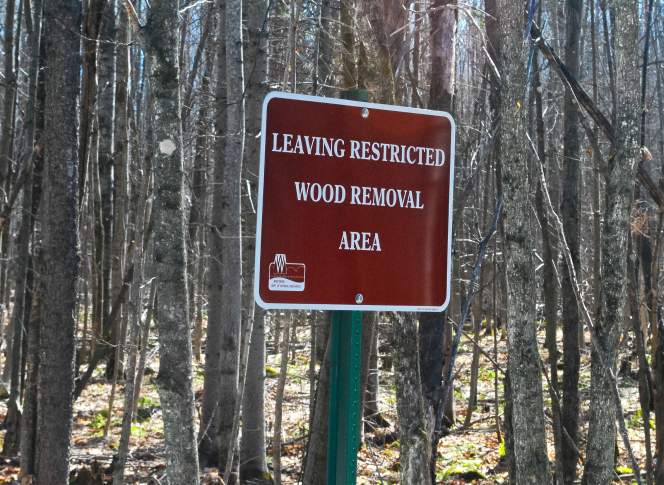Forestry Mill Tax Has Deep Roots In Wisconsin's Logging History
The potential cutting of a state-level property tax would change the way Wisconsin pays to maintain forests.
May 31, 2017

DNR wood removal sign at Argonne Experimental Forest in Forest County

The potential cutting of a state-level property tax would change the way Wisconsin pays to maintain forests.
Gov. Scott Walker’s 2017-19 budget proposal would eliminate the forestry mill tax. Whereas other property taxes in Wisconsin are levied by counties, cities, technical colleges, school districts and other units of local government, this tax is statewide, authorized in a 1924 amendment to the state constitution.
The forestry mill tax pays for the maintenance of 23 state forests, forest-fire prevention and suppression infrastructure, debt service on the state’s Knowles-Nelson Stewardship Fund, and other programs involving the health and economic and productivity of woodlands public and private. The state currently taxes property owners 16.97 cents for each $1,000 of a property’s value. In the state’s 2016-17 fiscal year, this tax raised $85,722,700 for the state.
An analysis from the nonpartisan Legislative Fiscal Bureau shows the median home value in Wisconsin in 2016 was $155,657 — someone owning a home with that value would have paid a total of $26 in forestry mill tax, just shy of 1 percent of their total property tax bill.
Walker’s proposal would get rid of that tax levy and instead fund forestry programs by drawing on the state’s general funds. His budget currently provides for general-fund transfers to replace these tax revenues through 2019, which, the administration contends, would approximate what the state would raise assuming property values keep steadily increasing. In the LFB’s analysis, this projection adds up. The question, then, is what happens to Wisconsin’s forestry funding starting in 2020.
State legislators initially created the tax to bring some certainty to management of forests. In the late 19th and early 20th century, aggressive logging made an indelible mark on Wisconsin’s forests, and left them full of dry remnants that fueled forest fires. By the time the 1920s rolled around, state leaders wanted to make sure timber resources didn’t vanish, and started creating forest management programs and buying the land that is now the Chequamegon-Nicolet National Forest, as noted in the LFB report. Most Wisconsinites experience these policies through recreation, but they are central to the state’s multi-billion-dollar timber and paper industries.
Supporters of the forestry mill tax say this funding is integral in areas of the state where logging and tourism are primary industries, supporting jobs and other economic impacts. Timber trade groups have expressed opposition to the budget proposal, saying the elimination of the tax would have a negative impact on their industry.
Most of the forestry mill tax revenues go to support programs in northern, more rural regions of the state, an allocation that at least one Wisconsin state legislator has cited in support of its elimination. More generally, Walker’s proposal has seen support among some but not all members of the legislature’s Republican majority. Chipping away at property tax levels in one form or another has been a hallmark of the Walker administration, but those are only one part of the overall taxes an individual or family directly pays.
For Tom Larson, a lobbyist for the Wisconsin Realtors Association, the bottom line is that the proposal would reduce property tax bills, even only by very small amounts for most home and landowners. On a May 26, 2017, interview on Wisconsin Public Television’s Here And Now, he said there’s broad support for forestry programs in the legislature, and characterized the change as “just shifting revenue sources.”
In the same Here And Now segment, Forest Stewards Guild executive director Fred Clark warned that if forestry programs depend on the state’s general fund, that means they’ll inevitably end up competing with other needs.
“The general fund in the state is not a bottomless well,” Clark said. “Public schools, parks programs, and other important programs in the state that are funded from general revenue see their budgets swing from year to year … You’re already hearing the debate about how we will pay for roads, how we will pay for public schools that badly need those resources.”
Comparing the forestry mill tax to road funding sounds ominous but is apt. State legislators don’t dispute that roads are vital to the state’s economy, or that the legislature has a responsibility to fund its transportation priorities, but legislators and Walker aren’t agreeing yet on how to get there.
Forestry could be headed for a similar dynamic — broad consensus that it’s a worthwhile investment, but division on how to pay for it.
 Passport
Passport











Follow Us